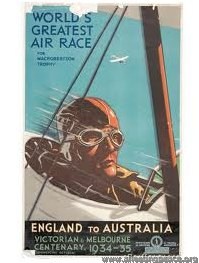| The Greatest Air Race (again): The 1934 MacRobertson Race from Mildenhall to Melbourne
The MacRobertson Race itself - probably the most successful air race of its kind, ever - is spendidly and copiously documented elsewhere. What is more difficult to find, is information about the people involved; many of them have fascinating stories, it turns out. I've also discovered that they got the handicap results wrong (although it's probably a bit late to say this, now, I suppose); and in these pages you can find, in exhausting detail, my reasoning. Whichever way you look at it, David and Kenneth Stodart in the Courier woz definitely robbed. |
|
The Story of the Race (from Alan Goodfellow's account)According to the Race Rules, all machines were required to be at Mildenhall for checking by 4.30pm on Sunday 14th October (less than a week before the start of the race), but in the event most of them were late, for one reason or another. On Saturday 13th there were no arrivals during the day but, as darkness fell, the Desoutter piloted by Michael Hansen arrived and then Wright and Polando’s red and white Lambert Monocoupe 145 ‘Baby Ruth’ appeared out of the dusk, roared overhead at nearly 200mph, and made a safe (if rather frightening) landing by the improvised light of car headlamps. The three D.H. Comets did arrive on Sunday but they all made very wobbly landings and Jim and Amy Mollison in ‘Black Magic’, the last to appear, made two abortive attempts (the second one even worse than the first) before finally landing. The others arrived gradually over the three following days. Jimmy Woods in his Lockheed Vega ‘Puck’ slipped quietly in at dusk on the Monday and brought off a perfect night landing, as befitted a pilot who had completed 12,000 hours in Australian airline service. On Tuesday, the impressive Boeing 247 arrived, but its pilot Roscoe Turner’s special design of uniform ‘afforded considerable amusement’. Ray Parer also arrived in the Fairey Fox, but did not look at all well; he had been in hospital with boils and other troubles. The two expected Italian competitors failed to appear, and the Italian Government issued a statement that in their opinion the rules favoured the British competitors, especially as ‘most of the compulsory stopping places are in British Territory’. During practice, Amy Mollison made a heavy landing and an undercarriage door fell off, then Cathcart Jones in the green Comet made a perfectly good landing but the undercarriage folded back and the machine ran along with sparks pouring from underneath the engine. The mechanics worked continuously for 21 hours to repair the damage and replace the propellers, but all three Comets had to go into the hangars to have their undercarriages strengthened. Several of the aircraft were overweight, and the crews had to cut down their personal equipment and, in Roscoe Turner’s case, to seal off 3 of the 10 fuel tanks in the Boeing. Jimmy Melrose said the weight of his D.H. 80 Puss Moth would be fine ‘as long as I’m not in it’. Although the formula had been published (and debated) for some time, the handicaps were not announced until Friday the 19th of October.
The StodartsApart from all these celebrity-aviators, two people seem to have passed almost unnoticed throughout this whole period, and indeed throughout the subsequent race; Dr. David Edmund Stodart and his distant cousin Kenneth Gerald Stodart. David was Australian by birth, Kenneth from the British branch of the family. David was, at 52, the oldest pilot in the race, with a distinguished career in the RFC and as a Squadron Leader in the post-WWI RAF, from which he had retired in 1931. He was described as ‘probably the most casual competitor in the race’. Kenneth was 24, a Sergeant Pilot in the RAF. After the race, they faded back into obscurity, and by the outbreak of WWII, five years later, they were both dead. Despite being one of only nine aircraft (and two of the seventeen pilots) to finish in time, they received no prizes – apart from the gold medallion for finishing within the sixteen days allowed. But arguably, if the Race Rules had been more fairly framed, they, instead of the DC-2 crew, would have won the Handicap race and with it the £2,000 (worth about £400,000 today, based on average earnings) and perhaps some of the glory they deserved.
|
||||



